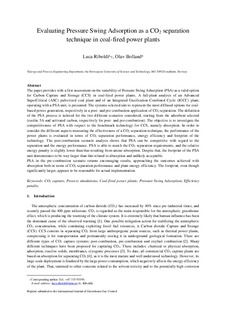| dc.contributor.author | Riboldi, Luca | |
| dc.contributor.author | Bolland, Olav | |
| dc.date.accessioned | 2017-10-31T13:39:35Z | |
| dc.date.available | 2017-10-31T13:39:35Z | |
| dc.date.created | 2015-05-16T19:19:11Z | |
| dc.date.issued | 2015 | |
| dc.identifier.citation | International Journal of Greenhouse Gas Control. 2015, 39 1-16. | nb_NO |
| dc.identifier.issn | 1750-5836 | |
| dc.identifier.uri | http://hdl.handle.net/11250/2463251 | |
| dc.description.abstract | The paper provides with a first assessment on the suitability of Pressure Swing Adsorption (PSA) as a valid option for Carbon Capture and Storage (CCS) in coal-fired power plants. A full-plant analysis of an Advanced SuperCritical (ASC) pulverized coal plant and of an Integrated Gasification Combined Cycle (IGCC) plant, operating with a PSA unit, is presented. The systems selected aim to represent the most diffused options for coal-based power generation, respectively in a post- and pre-combustion application of CO2 separation. The definition of the PSA process is tailored for the two different scenarios considered, starting from the adsorbent selected (zeolite 5A and activated carbon, respectively for post- and pre-combustion). The objective is to investigate the competitiveness of PSA with respect to the benchmark technology for CCS, namely absorption. In order to consider the different aspects measuring the effectiveness of a CO2 separation technique, the performance of the power plants is evaluated in terms of CO2 separation performance, energy efficiency and footprint of the technology. The post-combustion scenario analysis shows that PSA can be competitive with regard to the separation and the energy performance. PSA is able to match the CO2 separation requirements, and the relative energy penalty is slightly lower than that resulting from amine-absorption. Despite that, the footprint of the PSA unit demonstrates to be way larger than that related to absorption and unlikely acceptable. PSA in the pre-combustion scenario returns more encouraging results, approaching the outcomes achieved with absorption both in terms of CO2 separation performance and plant energy efficiency. The footprint, even though significantly larger than with absorption, appears to be reasonable for actual implementation. | nb_NO |
| dc.language.iso | eng | nb_NO |
| dc.publisher | Elsevier | nb_NO |
| dc.title | Evaluating Pressure Swing Adsorption as a CO2 separation technique in coal-fired power plants | nb_NO |
| dc.type | Journal article | nb_NO |
| dc.description.version | submittedVersion | nb_NO |
| dc.source.pagenumber | 1-16 | nb_NO |
| dc.source.volume | 39 | nb_NO |
| dc.source.journal | International Journal of Greenhouse Gas Control | nb_NO |
| dc.identifier.doi | 10.1016/j.ijggc.2015.02.001 | |
| dc.identifier.cristin | 1242934 | |
| dc.description.localcode | This is a submitted manuscript of an article published by Elsevier Ltd in International Journal of Greenhouse Gas Control, 16 May 2015 | nb_NO |
| cristin.unitcode | 194,64,25,0 | |
| cristin.unitname | Institutt for energi- og prosessteknikk | |
| cristin.ispublished | true | |
| cristin.fulltext | preprint | |
| cristin.qualitycode | 2 | |
